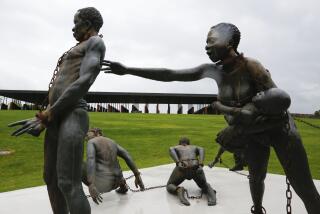Teen’s exoneration in 1944 slaying comes as relief to surviving relatives
Aime Ruffner recalled helping her 14-year-old brother, George Stinney Jr., graze the family cow one day in March 1944 in the tiny South Carolina town of Alcolu, deep in the Jim Crow South.
Ruffner, then 8 years old, testified at a court hearing in January that two young white girls approached the black siblings and asked where to find the best “may pops,” the fruit of a purple passionflower. Ruffner told them she didn’t know.
“Then they left and went about their business, and we went home,” Ruffner testified.
The next day, March 24, 1944, George was arrested and charged with murdering Betty June Binnicker, 11, and Mary Emma Thames, 7. They were found in a ditch, their skulls crushed. At his trial investigators testified that the girls were beaten with a 12-inch drift pin, a piece of metal that hitches railroad cars together.
Exactly a month later, on April 24, he was convicted by an all-white jury. On June 16, he died by electrocution — the youngest defendant executed in the United States in the 20th century.
Seventy years later, George’s conviction was vacated by a South Carolina judge, who cited “fundamental, constitutional violations of due process.”
His conviction and execution represent “a truly unfortunate episode in our history,” Circuit Court Judge Carmen T. Mullen wrote. Her ruling Wednesday gave some comfort to Ruffner and two other surviving siblings, who have maintained for seven decades that George was at home when the girls were killed.
“They are thrilled and relieved and still a bit stunned,” said Miller W. Shealy Jr., a Charleston School of Law professor who helped argue the Stinney siblings’ motion to vacate the 1944 conviction. “But it’s difficult for them to celebrate because no one’s coming home and no one’s getting out of prison.”
For decades, the Stinney case has been cited by civil rights lawyers as one of the South’s most blatant examples of racially biased Jim Crow justice. The all-male jury took just 10 minutes to convict the 14-year-old. That same day, George Stinney was sentenced to die.
Mullen noted that George was executed just 53 days after his conviction.
The boy’s lawyer “did little to nothing in defending Stinney,” the judge wrote. He presented no witnesses, and barely cross-examined the state’s handful of witnesses. He did not appeal the conviction or request a stay of execution.
A white investigator testified in 1944 that George confessed to killing the girls. But Mullen noted that George was separated from his parents, was not accompanied by a lawyer and was not read his rights.
Citing testimony at a two-day hearing in January by a forensic psychiatrist, the judge wrote: “It is highly likely that the defendant was coerced into confessing to the crimes due to the power differential between his position as a 14-year-old black male apprehended and questioned by white, uniformed law enforcement in a small, segregated mill town in South Carolina.”
Wilford “Johnny” Hunter testified in January that he spoke with George while both were in jail in March 1944. The boy told him “he didn’t kill those girls, and that they [police] made him say those things,” Hunter testified.
The hearing focused on whether George was afforded due process, not whether evidence exists that someone else killed the girls. A state prosecutor argued that the Stinney family lacked legal standing, and that authorities adhered to legal standards of the time. The prosecutor, Solicitor Ernest A. Finney III, is the son of the first African American to serve on the state Supreme Court in South Carolina since Reconstruction.
Shealy, the law professor, said the case turned on the application of coram nobis, a rarely used legal concept that dates from English common law. He said the defense relied on the concept to argue that the conviction was unfair or unlawful and that no other legal remedy was available.
Mullen noted that the Stinney case was exceptional and should not signal that families of defendants convicted decades ago can expect the same outcome.
Relatives of the murdered girls testified that resurrecting events from 70 years ago was painful. Frankie Bailey-Dyches, Betty June Binnicker’s niece, told the January hearing that defense witnesses had given testimony “I believe was false.”
“I believe he confessed,” Bailey-Dyches said of George Stinney. “He was tried and found guilty by the laws of 1944 ... and it needs to be left as is.”
Ruffner, in her testimony, recalled George’s arrest and said that she hid in a chicken coop when white police burst into the family home while her parents were away. The men drove off with George and another brother, Johnny, later releasing Johnny by tossing him from a moving police car.
“They accused George of killing those two girls, and I knew that was a lie,” Ruffner testified. She added: “I never saw my brother alive again.”
Ruffner, 78, said neither investigators nor the defense attorney questioned her about her contention that George went straight home with her after speaking with the girls and thus could not have killed them. George stayed home until that evening, when he and his father left to help searchers look for the missing girls.
The family fled their home after the trial, when told a white mob was on the way. After the execution, Ruffner said, they buried George in an unmarked grave for fear it would be desecrated by vengeful whites.
More to Read
Sign up for Essential California
The most important California stories and recommendations in your inbox every morning.
You may occasionally receive promotional content from the Los Angeles Times.











